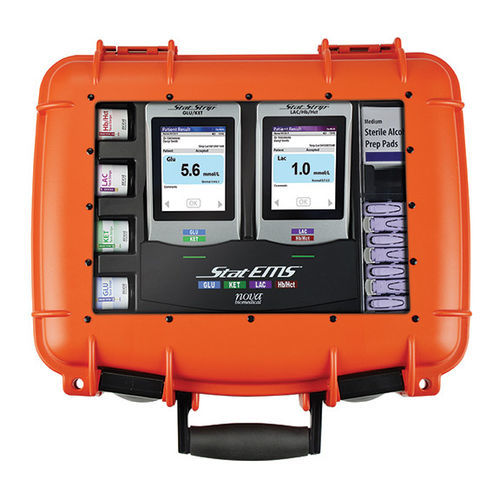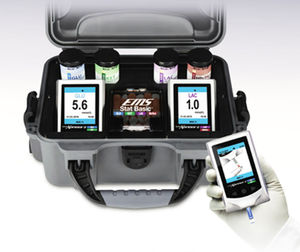
- Laboratory
- Laboratory medicine
- Sepsis POC analyzer
- Nova Biomedical

- Products
- Catalogs
- News & Trends
- Exhibitions
Sepsis POC analyzer EMS Stat Data Link™hematocritglucosehemoglobin
Add to favorites
Compare this product
Characteristics
- Applications
- sepsis
- Application field
- hematocrit
- Tested parameter
- glucose, hemoglobin, lactate, blood glucose
- Sample type
- blood, tissue
- Configuration
- portable
- Other characteristics
- wireless
Description
Lactate, Hemoglobin, Hematocrit, Glucose, and Ketone for early patient assessment and treatment
Fingerstick capillary sample, no blood draws
Results as fast as 6 seconds
Laboratory-quality accuracy
Durable carrying case holds meters, single-use biosensors, controls, and lancets
Meters store and transmit patient data
EMS Stat can measure lactate, hematocrit, hemoglobin, glucose, and ketone from a capillary blood drop. Results are available in seconds by using single-use biosensors and portable meters. EMS Stat offers simple, fast, and accurate testing in the field.
Two meter systems are available. One provides patient data storage plus wireless connectivity to external data managers, the other provides data storage only.
Test Menu
EMS Stat provides important tests to help patient assessment, and emergency treatment. These tests can also help determine the appropriate transport site for patients with trauma, sepsis, or other specialized needs.
LactateElevated blood lactate is a rapid, sensitive indicator of tissue hypoxia, sepsis, septic shock, and hypovolemic shock.7-9
For ambulance patients, lactate testing provides:
Early, more sensitive detection of hypoperfusion during sepsis and septic shock than vital signs alone8
Identification of patients with sepsis who might benefit from early goal-directed therapy and advanced activation of medical staff at the transport site
Evaluation of trauma, critical illness, hemorrhage, acute coronary syndrome, acute respiratory failure, and chest and abdominal pain
Abnormal glucose levels are frequently encountered in ambulance patients. Medical conditions that warrant pre-hospital blood glucose testing include diabetes,
Related Searches
- Laboratory analyzer
- POC reader
- Control analyzer
- Temperature analyzer
- Oxygen analyzer
- Flow analyzer
- Electrolyte analyzer
- Blood POC reader
- Automatic electrolyte analyzer
- Human electrolyte analyzer
- Benchtop electrolyte analyzer
- Protein POC reader
- Infectious disease POCT analyzer
- POC reader with touchscreen
- Portable POC reader
- Whole blood POC reader
- CO2 analyzer
- Analyzer with touchscreen
- PH analyzer
- Clinical POC reader
*Prices are pre-tax. They exclude delivery charges and customs duties and do not include additional charges for installation or activation options. Prices are indicative only and may vary by country, with changes to the cost of raw materials and exchange rates.

